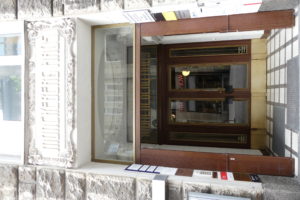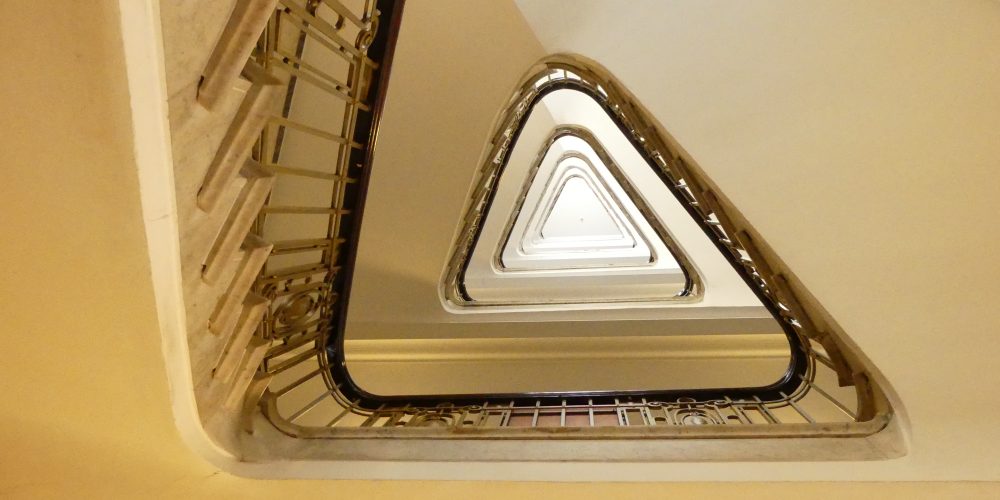Staircase up – staircase down in the Mönckeberghaus

 After the first modern staircase last week, this week, I’ll dedicate my blog to a more historical office building and its staircase: The Mönckeberghaus. As the name suggests, it is located on Mönckebergstraße in the middle of the city centre and yet is somewhat inconspicuously hidden in the second row bhind the Mönckeberg fountain. The architect Claus Meyer disigned the building, which was completed in 1909 as a rental accounting house, with the master mason Ferdinat Usinger.
After the first modern staircase last week, this week, I’ll dedicate my blog to a more historical office building and its staircase: The Mönckeberghaus. As the name suggests, it is located on Mönckebergstraße in the middle of the city centre and yet is somewhat inconspicuously hidden in the second row bhind the Mönckeberg fountain. The architect Claus Meyer disigned the building, which was completed in 1909 as a rental accounting house, with the master mason Ferdinat Usinger.
The Kontorhaus follows the curve of the street and is decorated on the outside with gargoyles and geometric and historicist ornaments. After the roof truss had been destroyed in the Second World War, a set-back storey was added during the reconstruction in 1949. Although the staircase has lost some of its original elegance over the course of several modernisation and renovation projects, the marble entrance mullion, the golden-metallic stair rods in the style of the Wiener Werkstätten, and the occasional decorative ornaments on the walls, which are tiled in an iridescent green, indicate its former charm. Curving in a triangle, the marble staircase runs up pas various offices, until today. At one end, a window allows plenty of daylight from the atrium into the stairwell.
TIP: Use the break during shopping on the Mö for something extraordinary.
How much I would love to take you through the Hanseatic city as a certified tourist guide on a city tour or a staircase tour, but unfortunately, we are currently not allowed to do so. New in my programme are therefore online tours, onto which I can take you comfortably from home! Feel free to contact me to arrange a guided tour later this year or an online tour. I’m looking forward to your ideas or you can just fhave a look at my Hamburg Tours to see, which of my city sightseeing guided tours suits best your taste.
Mayor Mönckeberg
Johann Georg Mönckeberg (1839-1908) died in his seventh mandate as 1st mayor of the city of Hamburg and is therefore the mayor most often in that highest position of the senate next to Gustav Heinrich Kirchenpauer. But you should consider the fact that from 1860 until the Republic of Weimar in 1918 the mandate of the 1st mayor was only one year long. Before that year, you usually were occupying the position of 2nd mayor and afterwards you took a year of „break“.
The street Mönckeberstraße, the fountain Mönckebergbrunnen and the Mönckeberghaus are all named after this former mayor, who was nicknamed as „stinge“ thanks to his dominion of the finances. He gained popularity by standing up against the robbery of the right of vote in 1905, which had been suggested by the more wealthy.
After his law studies Mönckeberg started to work as a lawyer and also was member of the supervisory board in the Berlin-Hamburg Railway Society. He had been born in Hamburg and died there as well. He is buried on the famous Ohlsdorf Cemetary in the Mönckeberg family grave.
Stairwells and their function(s)
Stairwell are and were not only purpose-build edifices to climb up or go down but are and were places of communication and representation. Searching for impressive and beautiful staircases today, you can find a lot of obstacles, like advertising signs, crowded shopping windows and store doors. Nevertheless, it really is worth the try!
Many of the staircases in Hamburg, especially in the accounting houses, do not let you miss any of their former splendour and decoration. Although the construction of a staircase always means a compromise between the aesthetics and economy as well as between the desires of the investor and the requirements of the architects, we can find many staircases in Hamburg comparable to reception halls – possbily thanks to the eagerness to represent their wealth of the merchants in Hamburg. At the same time, their impressive and power-radiating outsides serve to hide all of the functional parts. Decorations like carved, chiseled or cast plants, flowers and masks made of wood, stone or bronze, arcs, filigree grids, marble or granite distract from the functions of the building.
„Entrees, Foyers and stairwells are representative rooms. They establish the connection between the public street and the semi-public building, they are not outside anymore but not yet inside. Therefore, stairwells do not only fulfil the function task of linking the different floors within the edifice, the mediate, they have a communicative task as places of encounter, as a symbol of movement.“ (from „Hamburger Treppenhäuser“ by Allenstein and Pasdzior)
TIP: Borrow that book from the public libraries of Hamburg Hamburger Bücherhallen, read and admire the pictures! There is a lot to discover! Or simply go on a guided (online) tour with me!

